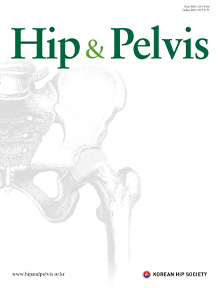Quick links
Related article in
-
Original ArticleJune 30, 2017
 0
0
 99
99
 26
26

Pelvic Insufficiency Fracture in Severe Osteoporosis Patient
Woong Chae Na, MD, Sang Hong Lee, MD, Sung Jung, MD, Hyun Woong Jang, MD, Suenghwan Jo, MD
Hip Pelvis 2017; 29(2): 120-126AbstractPurpose: To evaluate clinical features and the effect of parathyroid hormone (PTH) on treatment outcomes of patients with pelvic insufficiency fractures.
Materials and Methods: Fifteen patients diagnosed with pelvic insufficiency fractures were evaluated retrospectively. All patients had osteoporosis with mean lumbar T score of –3.9 (range, –3.1 to –6.4) and the mean age was 76.5 years. In all cases, simple radiography and computed tomography was used for final diagnosis; additional magnetic resonance imaging and technetium bone scans were used to confirm the diagnosis in 2 and 6 patients, respectively. Initial conservative treatment was used in all cases; treatment with PTH was applied in 5 cases. Radiological follow-up was done every 4 weeks up to 6 months and every 3 months thereafter. Symptom improvement was measured using visual analogue scale (VAS) score.
Results: Fractures were located: i) sacrum and pubis (9 cases), ii) isolated sacrum (4 cases) and iii) isolated pubis (2 cases). One case showed fracture displacement and pain aggravation at 4 week follow-up which was treated with percutaneous sacro-iliac fixation using cannulated screws. Duration of bone union was significantly shorter in the patients who used PTH (P<0.05). VAS scores were also lower in the group treated with PTH; however, statistical significance was not reached.
Conclusion: In patients with osteoporosis, a pelvic insufficiency fracture should be considered if pain is experienced in the pelvic area in the absence of major trauma. While nonoperatic has been shown to be sufficient for treatment, our study shows that PTH therapy shortens treatment period and could be a favorable treatment option. -
Original ArticleMarch 1, 2024
 0
0
 443
443
 115
115
Bone Health Evaluations and Secondary Fragility Fractures in Hip Fracture Patients
Emily M. Pflug, MD
Hip Pelvis 2024; 36(1): 55-61 , Ariana Lott, MD
, Ariana Lott, MD  , Sanjit R. Konda, MD
, Sanjit R. Konda, MD  , Philipp Leucht, MD, PhD
, Philipp Leucht, MD, PhD  , Nirmal Tejwani, MD
, Nirmal Tejwani, MD  , Kenneth A. Egol, MD
, Kenneth A. Egol, MD  AbstractPurpose: This study sought to examine the utilization of bone health evaluations in geriatric hip fracture patients and identify risk factors for the development of future fragility fractures.
AbstractPurpose: This study sought to examine the utilization of bone health evaluations in geriatric hip fracture patients and identify risk factors for the development of future fragility fractures.
Materials and Methods: A consecutive series of patients ≥55 years who underwent surgical management of a hip fracture between September 2015 and July 2019 were identified. Chart review was performed to evaluate post-injury follow-up, performance of a bone health evaluation, and use of osteoporosis-related diagnostic and pharmacologic treatment.
Results: A total of 832 patients were included. The mean age of the patients was 81.2±9.9 years. Approximately 21% of patients underwent a comprehensive bone health evaluation. Of this cohort, 64.7% were started on pharmacologic therapy, and 73 patients underwent bone mineral density testing. Following discharge from the hospital, 70.3% of the patients followed-up on an outpatient basis with 95.7% seeing orthopedic surgery for post-fracture care. Overall, 102 patients (12.3%) sustained additional fragility fractures within two years, and 31 of these patients (3.7%) sustained a second hip fracture. There was no difference in the rate of second hip fractures or other additional fragility fractures based on the use of osteoporosis medications.
Conclusion: Management of osteoporosis in geriatric hip fracture patients could be improved. Outpatient follow-up post-hip fracture is almost 70%, yet a minority of patients were started on osteoporosis medications and many sustained additional fragility fractures. The findings of this study indicate that orthopedic surgeons have an opportunity to lead the charge in treatment of osteoporosis in the post-fracture setting. -
Original ArticleMarch 1, 2024
 0
0
 646
646
 230
230

Treatment of Osteoporosis after Hip Fracture: Survey of the Korean Hip Society
Jung-Wee Park, MD
Hip Pelvis 2024; 36(1): 62-69 , Je-Hyun Yoo, MD*
, Je-Hyun Yoo, MD*  , Young-Kyun Lee, MD
, Young-Kyun Lee, MD  , Jong-Seok Park, MD†
, Jong-Seok Park, MD†  , Ye-Yeon Won, MD‡
, Ye-Yeon Won, MD‡  AbstractPurpose: To assess current practice in the treatment of osteoporosis in patients who underwent treatment for hip fracture in South Korea.
AbstractPurpose: To assess current practice in the treatment of osteoporosis in patients who underwent treatment for hip fracture in South Korea.
Materials and Methods: A survey of 97 members of the Korean Hip Society, orthopedic hip surgeons who administer treatment for hip fractures in South Korea, was conducted. The survey was conducted for assessment of demographic data and perceptions regarding the management of osteoporosis in patients who have undergone treatment for hip fracture. Analysis of the data was performed using descriptive statistical methods.
Results: The majority of participants were between the age of 41 and 50 years, and 74% were practicing in tertiary hospitals. Testing for serum vitamin D levels (82%) was the most commonly performed laboratory test. Calcium and vitamin D were prescribed for more than 80% of patients by 47% and 52% of participants, respectively. Denosumab was the most commonly used first-line treatment option for osteoporosis in hip fracture patients. Bisphosphonate was most often perceived as the cause of atypical femoral fractures, and the most appropriate time for reoperation was postoperative 12 months. Teriparatide was most preferred after cessation of bisphosphonate and only prescribing calcium and vitamin D was most common in high-risk patients for prevention of atypical femoral fracture.
Conclusion: The results of this study that surveyed orthopedic hip surgeons showed that most participants followed the current strategy for management of osteoporosis. Because the end result of osteoporosis is a bone fracture, active involvement of orthopedic surgeons is important in treating this condition.
- 1

Vol.36 No.1
Mar 01, 2024, pp. 1~75
Most Keyword
?
What is Most Keyword?
- It is most registrated keyword in articles at this journal during for 2 years.
Most View
-
Pathophysiology and Treatment of Gout Arthritis; including Gout Arthritis of Hip Joint: A Literature Review
Yonghan Cha, MD
Hip Pelvis 2024; 36(1): 1-11 , Jongwon Lee, MD
, Jongwon Lee, MD  , Wonsik Choy, MD
, Wonsik Choy, MD  , Jae Sun Lee, PhD*,†
, Jae Sun Lee, PhD*,†  , Hyun Hee Lee, MD‡
, Hyun Hee Lee, MD‡  , Dong-Sik Chae, MD‡
, Dong-Sik Chae, MD‡ 
-
Treatment of Osteoporosis after Hip Fracture: Survey of the Korean Hip Society
Jung-Wee Park, MD
Hip Pelvis 2024; 36(1): 62-69 , Je-Hyun Yoo, MD*
, Je-Hyun Yoo, MD*  , Young-Kyun Lee, MD
, Young-Kyun Lee, MD  , Jong-Seok Park, MD†
, Jong-Seok Park, MD†  , Ye-Yeon Won, MD‡
, Ye-Yeon Won, MD‡ 
Editorial Office
Laboratory tests performed in hip fracture patients. CTX: carboxy-terminal telopeptide of collagen I, PTH: parathyroid hormone, P1NP: procollagen type I N propeptide, U/A: urinalysis.|@|~(^,^)~|@|First-line treatment option for osteoporosis in hip fracture patients. BP: bisphosphonate, PTH: parathyroid hormone, SERM: selective estrogen receptor modulator.|@|~(^,^)~|@|Osteoporosis medication in patients with rebound phenomenon after cessation of denosumab. Ca+Vit. D: calcium and vitamin D, PTH: parathyroid hormone, SERM: selective estrogen receptor modulator.|@|~(^,^)~|@|The most important recognized factor for atypical femoral fracture.|@|~(^,^)~|@|Preferred osteoporosis medications after cessation of bisphosphonate in patients with atypical femoral fracture. PTH: parathyroid hormone, Ca+Vit. D: calcium and vitamin D, SERM: selective estrogen receptor modulator.|@|~(^,^)~|@|Preferred osteoporosis medications in patients with high-risk of atypical femoral fracture. Ca+Vit. D: calcium and vitamin D, SERM: selective estrogen receptor modulator, PTH: parathyroid hormone.
Hip Pelvis 2024;36:62~69 https://doi.org/10.5371/hp.2024.36.1.62
© H&P
© 2024. The Korean Hip Society. Powered by INFOrang Co., Ltd




 Cite
Cite PDF
PDF



